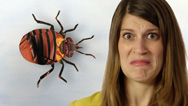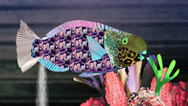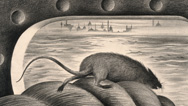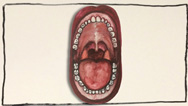How Pee Can Change the World
- By Anna Rothschild
- Posted 09.17.15
- NOVA
We can use urine to make medicines, power cell phones, and create “pee-cycled” water. Find out more in this episode of Gross Science.
Transcript
How Pee Can Change the World
Posted: September 17, 2015
What can you do with old pee? According to scientists, quite a lot.
I’m Anna Rothschild, and this is Gross Science.
So, the idea of recycling pee is nothing new. To get a pearly white smile, ancient Romans used to soak their teeth in it, and early Europeans used it to clean their clothes. Thankfully most people are no longer walking around in dried urine, but today, scientists are unlocking the potential of pee and discovering that it’s really nothing to turn up your nose at.
For example, scientists can actually make medicines using chemicals extracted from pee. Back in the 1950s, a doctor named Bruno Lunenfeld realized that when women enter menopause, they naturally release high levels of fertility hormones in an effort to get rid of any eggs they might have left. Lunenfeld wanted to see if these hormones could be extracted from urine, but to do that, he needed gallons and gallons of pee from older women. So where did he turn? To convents! Lunenfeld collected pee from about 300 nuns and used it to extract human urinary menopausal gonadotropin, or hMG for short, which is still used in fertility drugs today.
And that’s not all. Pee is powerful stuff. …literally. You can actually use it to generate electricity. Certain kinds of bacteria feast on the nutrients in urine. The bacteria in turn produce electrons, which flow into an electrode, creating a current that can power cell phones or lights in remote locations like refugee camps. Pee-powered electricity is still being tested, but the technology is promising and offers a way to keep the lights on using a truly renewable power source.
Perhaps the most important and widespread use of pee is as a source of water. For example, since water is heavy and difficult to transport to space, astronauts on the International Space Station extract it from their urine. The “pee-cycled” water on the ISS is not only drinkable, it’s actually purer than the water that comes out of your faucet at home.
And speaking of which, your tap water might already contain some recycled urine. In drought-stricken parts of the country, like California and Texas, urine gets purified and filtered back into the water system. Wastewater recycling systems are already in place in Israel and Singapore and they could be coming to your town as an increasing number of locales face water shortages.
Americans produce 32 billion gallons of sewage every single day and a lot of that is pee. With all that urine, we could be creating a ton of water, medicine, and energy for those in need. So keep peeing people. For the good of humanity, keep peeing.
Ew.
Credits
PRODUCTION CREDITS
- Host, Editor, Animator
- Anna Rothschild
- Writer
- Christina Couch
- DP, sound
- Sam Stulin
- Applied Sunblock A
- Music Provided by APM
- Special thanks to Dr. Ioannis Ieropoulos and the Orange County Water District.
IMAGES AND VIDEO
- Mobile phone runs on urine power - Bristol Robotics Laboratory
-
Courtesy University of the West of England (UWE),
Bristol
https://www.youtube.com/watch?v=4LTprRQTKAw - Orange County’s Groundwater Replenishment System
- Jim Kutzle, Orange County Water District
- Microfiltration Basin
- Orange County Water District
- Reverse Osmosis trains of the Groundwater Replenishment System
- Steve Crise, courtesy of American Water Works Association (AWWA)
- Crystal-clear purified water from the Groundwater Replenishment System is piped to OCWD’s percolation ponds in Anaheim, California
- Mark Greening, Orange County Water District
- MF Cell
- Steve Crise, courtesy of the American Water Works Association (AWWA)
- Woman Teeth
- iStock/Kurhan
- Clothesline
- iStock/TheCrimsonMonkey
- Filling glass with tap water
- iStock/vitapix
- Elvis Presley Jailhouse Rock
- Wikimedia Commons/Metro-Goldwyn-Mayer, Inc.
- Gentlemen Prefer Blondes Movie Trailer Screenshot (34)
- Wikimedia Commons/Mddlpps
- Nuns clamming -Toni Frissell LC-F9-04-57090012-17
- Wikimedia Commons/Toni Frissell
- Portrait de Dante
- Wikimedia Commons/Sandro Botticelli
- Sputnik 191378-full
- Wikimedia Commons/NASA
- Symptoms of menopause (raster)
- Wikimedia Commons/Mikael Häggström
- Toilet on the ISS
- NASA
SFX
- Cockroaches
-
Freesound/StateAardvark
(used with permission from author) - Squeak Pack/squeak_10
- Freesound/Corsica_S
- Wink
- Freesound/Bennychico_11
- cough cough sniff sniff
- Freesound/harrypeeks
- light-1
- Freesound/tictacshutup
- Peeing
- Freesound/Safadancer
- Produced by WGBH for PBS Digital Studios
Sources
Want more info?
From Gunpowder to Teeth Whitener: The Science Behind
Historic Uses of Urine, from Smithsonian:
http://bit.ly/1LkDKWb
Management of Infertility: Past, Present and Future (from a
personal perspective), by Bruno Lunenfeld:
http://bit.ly/1LkFiPZ
‘Pee-Power’ to light camps in disaster zones, from UWE
Bristol:
http://bit.ly/1LkDTsK
Urine-tricity, from Bristol Robotics Laboratory:
http://bit.ly/1LkDZ3w
From toilet to tap: Getting a taste for drinking recycled
waste water, from CNN:
http://cnn.it/1LkEgTZ
Orange County’s Groundwater Replenishment System:
http://bit.ly/1LkKxPq
Related Links
-

Gross Science
Bizarre stories from the slimy, smelly, creepy world of science.
-

Beaches Made of Fish Poo
Parrotfish poop out sand, and that’s just the beginning of what makes these guys weird.
-

What is the Black Plague?
Plague sounds like a medieval disease, but there are a few cases in the US every year.
-

What Are Tonsil Stones?
If you’ve got white lumps in your throat, they could be tonsil stones or “tonsilloliths.”

